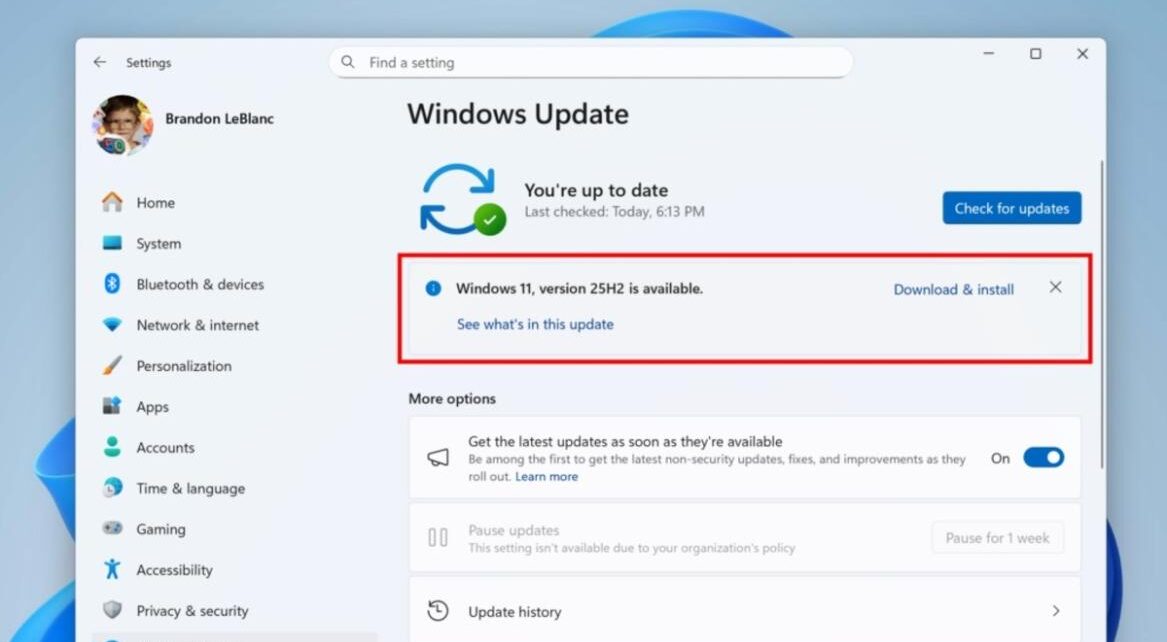Microsoft has begun rolling out the Windows 11 25H2 update to Windows Insiders in the Release Preview channel. This marks the biggest Windows 11 annual update of the year, identified as Build 26200.5074, and it is being distributed to Insiders ahead of its general availability slated for October. The rollout underscores Microsoft’s ongoing cadence of annual feature updates for Windows 11, with the Release Preview channel serving as a testing ground where new changes are scrutinized before they reach the broader audience.
In this release, the 25H2 update is delivered through an enablement package. This is a direct consequence of 25H2 and the prior 24H2 sharing the same servicing branch, known as the Germanium platform. An enablement package means that the majority of features have already been delivered through earlier cumulative updates; the 25H2 update’s role is primarily to enable those features on systems that have already received the necessary groundwork. For end users, this translates into a streamlined upgrade path that requires only a single reboot to activate the enabled features, rather than installing a large, feature-heavy update package. The practical effect is a smoother post-update experience for many devices, with less downtime and a more predictable rollout.
For those who want to install the Windows 11 25H2 update, the recommended route is to join the Windows Insider Program and select the Release Preview channel. After joining, users should check for updates in Windows Update, and the system will offer the Windows 11 25H2 upgrade once it becomes available on their devices. This process aligns with Microsoft’s Insider strategy, which aims to balance early access with cautious deployment, thereby allowing testers to validate stability, compatibility, and performance across a diverse range of hardware configurations before a wider public release. The approach also helps Microsoft gather feedback on any remaining issues that could affect the broader user base once the update becomes generally available.
Microsoft has stated in its official blog that the Windows 11 25H2 update will remove PowerShell 2.0 and the Windows Management Instrumentation (WMIC) command-line tool. This decision carries implications for scripting, automation, and administration, especially for environments that historically relied on these legacy components. The blog note indicates the removal but does not specify all downstream changes or the exact migration path for existing scripts. In practical terms, administrators and power users should anticipate the need to transition to newer automation approaches, such as newer versions of PowerShell (for example, PowerShell 7.x) and modern cmdlet replacements for WMIC operations. It is essential to review any workflows, automation tools, or deployment scripts that depend on PowerShell 2.0 or WMIC, and to plan for corresponding updates to ensure continued compatibility and security.
Beyond the known removals, the official communication leaves open questions about what new features will arrive with the Windows 11 2025 update. There is speculation that we may see several user experience and productivity enhancements, including a redesigned Start Menu, the application of a dark mode across system elements, and the option to disable lock screen widgets. There is also anticipation around a suite of AI features aimed at Copilot-enabled PCs, as part of broader efforts to integrate artificial intelligence more deeply into the Windows experience. While concrete feature confirmations for 25H2 remain limited, the potential for these enhancements reflects Microsoft’s ongoing emphasis on improving usability, personalization, and AI-assisted productivity across Windows 11 devices. Readers and users are encouraged to monitor official updates and release notes for precise feature rollouts and any caveats.
This rollout is part of a broader strategy to refine Windows 11 through iterative updates that balance new capabilities with stability and security. The enablement package model for 25H2 demonstrates Microsoft’s intent to minimize disruption while ensuring users can access the latest improvements without the heavy payload traditionally associated with major feature upgrades. For organizations and individual users alike, the emphasis on a single reboot simplifies scheduling and reduces downtime, particularly in environments where batch updates and testing windows are critical. The Release Preview channel remains a key pathway for stakeholders to validate performance, compatibility, and user experience in real-world conditions before widespread deployment.
Understanding the practical implications of 25H2 requires a close look at how enablement packages operate within the Windows servicing model. An enablement package is not a standalone, feature-laden installation but a small, targeted package designed to unlock features that are already present on the OS image due to prior updates. This means that while the system is technically updated to the 25H2 version, the functional capabilities users notice—such as updated UI elements or enhanced security features—may already be integrated and merely activated through the enablement step. The benefit here is twofold: users experience a faster completion of the upgrade journey, and Microsoft can deliver features in a controlled, incremental manner, ensuring that each activation is supported by a long tail of reliability testing.
For Windows Insider participants, there are several practical steps to maximize the value of the 25H2 rollout. First, ensure that the device is enrolled in the Windows Insider Program and that the Release Preview channel is selected. Then, perform a manual check for updates in Windows Update to trigger the availability of the 25H2 enablement package. It is important to back up critical data before applying any major update, even when the process is designed to be straightforward. Post-installation, users should monitor system performance, feature availability, and overall stability, reporting any anomalies through the Insider feedback channels. Businesses evaluating the Insider program should consider the implications for IT governance, including change management, device compatibility testing, and user communication plans to manage expectations during the early rollout phase.
From a technical perspective, the removal of PowerShell 2.0 and WMIC is a notable shift that will influence scripting strategies and legacy administrative practices. Developers and IT professionals should take proactive steps to adapt by transitioning to modern automation approaches. This may include adopting PowerShell 7.x or newer, leveraging cross-platform scripting capabilities, and adopting alternative management frameworks that rely on developments in Windows Management Infrastructure (MI) and modern CIM/WMI APIs. The migration path may require updating existing scripts, converting batch or VBScript-based workflows to PowerShell-based solutions, and revalidating automation routines to ensure compatibility with future Windows updates. Security considerations also arise from removing legacy components, as newer tools typically include updated security features and support.
In parallel with the enablement approach, the anticipated 2025 update cycle hints at ongoing innovation in Windows 11. The potential introduction of a redesigned Start Menu and a pervasive dark mode across system components points to a broader aesthetic and usability revamp. The possibility of configurable lock screen widgets and expanded Copilot+ AI features on PCs suggests a shift toward more customizable, AI-assisted workflows. If these features materialize, they could influence how users interact with the desktop, manage tasks, and access information, potentially affecting productivity and user satisfaction. However, until Microsoft provides explicit feature confirmations and roadmaps, readers should regard these developments as credible possibilities rather than guaranteed outcomes. The evolving AI feature set will also carry implications for performance, privacy, and control, requiring users to weigh convenience against data handling considerations.
The Windows Insider program continues to serve as a valuable window into Microsoft’s ongoing development and testing cycle for Windows 11. By engaging with the Release Preview channel, participants gain early exposure to significant updates while contributing feedback that can shape final in-market releases. The staged rollout approach helps Microsoft identify and address issues that might not surface in isolated environments, thereby reducing risk for the broader user base when the update becomes generally available. For organizations, participating in the Insider program can be a strategic way to validate hardware compatibility, software integration, and logistical readiness for a broader distribution, as well as to align internal support processes with anticipated changes in the Windows operating system.
In addition to the update mechanics, it is important to consider the broader ecosystem of Windows 11 updates and how they intersect with enterprise IT, developer workflows, and user experiences. The 25H2 update’s status as an enablement package reinforces the importance of proactive change management, ensuring that all stakeholders understand the upgrade path, feature activation timing, and potential adjustments to existing tools and processes. It also highlights the need for ongoing assessment of device readiness, including hardware capabilities, drivers, and compatibility with third-party software. Enterprises should plan for a measured deployment, leveraging pilot groups and staged rollouts to collect feedback and mitigate risk. By preparing in advance, organizations can capitalize on the benefits of new features while maintaining stability and security across the Windows environment.
As the industry watches for confirmation on the exact feature set accompanying the Windows 11 25H2 update and the broader 2025 update cycle, users should be mindful of the update’s operational realities. The reliance on an enablement package can simplify the user experience, but it also demands careful attention to the state of prior updates and the readiness of activated features. The removal of PowerShell 2.0 and WMIC underscores the evolution toward more modern, secure, and maintainable management tools. While the precise new capabilities will become clearer with forthcoming documentation and release notes, the 25H2 update stands as a milestone in Microsoft’s ongoing modernization of Windows 11, reinforcing the company’s commitment to iterative improvements, AI-enhanced productivity, and a refined user experience across devices.
Conclusion
The Windows 11 25H2 update represents a significant milestone in Microsoft’s ongoing modernization of Windows 11 through annual feature updates. Delivered via an enablement package on the same Germanium servicing branch as 24H2, this release underscores a streamlined upgrade path that activates features already delivered in prior updates with just a single reboot. The rollout to Insiders in the Release Preview channel provides a crucial testing ground for stability, compatibility, and user experience before general availability in October. The removal of PowerShell 2.0 and WMIC signals a shift toward modern administration practices and renewed emphasis on security and maintainability, prompting IT professionals and developers to update automation workflows accordingly. While details about new features for the 2025 update remain to be confirmed, expectations include a redesigned Start Menu, system-wide dark mode, lock screen widget controls, and expanded AI features for Copilot-enabled PCs, reflecting Microsoft’s focus on usability, aesthetics, and AI-assisted productivity. For participants and organizations pursuing early access, the Release Preview channel offers a pathway to observe evolving capabilities, test compatibility, and prepare for broader deployment, all while contributing valuable feedback to shape the final Windows 11 experience. The 25H2 update, with its enablement approach and forward-looking feature trajectory, illustrates how Windows 11 is evolving to meet contemporary needs, balancing innovation with reliability, and positioning Windows as a more capable, AI-aware platform for both consumers and enterprise alike.



